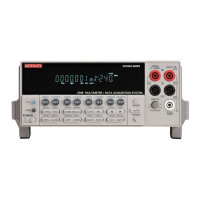4-14 Range, Digits, Rate, Bandwidth, and Filter Model 2700 Multimeter/Switch System User’s Manual
Filter type
There are two digital filter types: moving and repeating. The moving average filter uses a
first-in first-out stack, where the newest reading conversion replaces the oldest. An aver
-
age of the stacked reading conversions yields a filtered reading. After the specified number
of reading conversions (“
Filter count”) fill the stack, the moving filter gives a new reading
for every new conversion. This process is depicted in Figure 4-2A.
The repeating filter takes a specified number of conversions, averages them and yields a
filtered reading. It then flushes its stack and starts over. This character is useful when scan
-
ning (readings for other channels are not averaged with the present channel). The stack is
then cleared and the process starts over (see
Figure 4-2B).
NOTE The moving filter cannot be used when scanning. If a scan channel is set up to
use the moving filter, the filter will not turn on. Scanning is covered in
Section 7.
Filter count
The filter count specifies how many consecutive A/D conversions (within the filter
window) to place in the memory stack. When the stack is full, the A/D conversions are
averaged to calculate the final filtered reading. The filter count can be set from 1 to 100.
Note that with a filter count of 1, no averaging is done. However, only readings within the
“
Filter window” will be displayed, stored, or transmitted.
NOTE While the filter processes readings, the FILT annunciator blinks. Readings that
are being displayed while the FILT annunciator blinks are not final filtered
readings. When the FILT annunciator stops blinking, the filter has settled.

